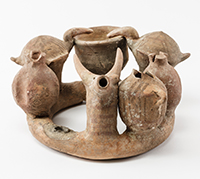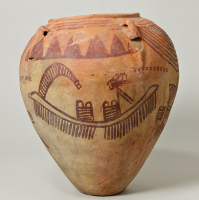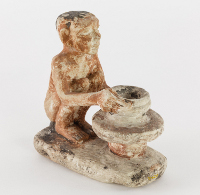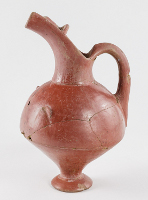Highlights from the Collection: Pottery
Beaker with Geometric Designs and Birds
Archaeologists working in Iran at the site of Tepe Giyan during 1931 and 1932 excavated 119 burials dating to five successive periods. Among the vessels characteristic of the Giyan II Period were ones whose decoration combined geometric patterns with representations of small suns and birds. This beaker, acquired by the archaeologist Ernst Herzfeld prior to the 1930's excavations, thus can be dated by its decoration to Giyan II.
Painted Jar
This handmade vessel has a lozenge pattern on the shoulder painted in black on a plum-red burnished surface. This type of ware and decoration are characteristic of a phase in the development of Iranian civilization on the central plateau that is often called "Cheshmeh Ali" after a site of that name near Tehran.
Kernos Ring
This ring was probably used as a libation vessel during religious ceremonies in ancient Palestine. It consists of a hollow clay ring with hollow clay attachments in the forms of a gazelle head, two jars, two pomegranates, two doves, and a cup. The doves, whose heads have been restored, drink from the cup. An eighth attachment is missing, having been broken off in antiquity.
The pomegranate, the gazelle and the doves suggest that this ring was associated with a fertility cult. Wine or water would have been poured into the cup and circulated through the other objects attached to the ring, thus symbolizing the fertility of the earth and its produce.
Kernos rings are fairly common in Palestine, although few are as elaborate or as well preserved as this one.
Predynastic Jar
Most striking of the painted designs on this pot are the boats, which carry banks of oars, cabins or shrines, and standards. Other decorations include a large bird, probably an ostrich, and images evocative of the hills and water of Upper Egypt, where this vessel was made. Strings probably were passed through the four pierced beak-shaped lugs near the rim and used to tie a lid securely in place. Handmade pots with painted decorations like these were characteristic of the Gerzean period.
Potter
Ny-kau-Inpu, a cemetery official who was probably buried in a mastaba in the Old Kingdom cemetery at Giza, included in his tomb a series of statuettes of his family and household servants. By so doing, he hoped to take with him into the afterlife those things that were important to him during his lifetime. This tiny figure of a potter forming a vessel upon a potter's wheel was one of those statuettes, which as a group seem to represent the staff of a typical properous estate owner in Old Kingdom Egypt.
Pitcher with built-in strainer
This gracefully shaped pitcher was a mortuary gift in a communal burial chamber. The highly polished exterior has a brown-red slip and shows striations of the polishing stone. Two breast-like protuberances placed on the upper body of the vessel lend it a slight anthropomorphic air. The elegant spout curves upward from the neck and is supplied with a strainer to remove impurities from the liquid that was poured through it.
Krater of Khirbet Kerak Ware
This jar is made of a specific ware named after the Palestinian site of Khirbet Kerak, where it was first discovered. Vessels of Khirbet Kerak ware were made by hand and covered both inside and out with a brilliantly polished slip, originally orange-red in color (as on the interior of this vessel) but turned to black on the exterior by specialized treatment during firing. This large pot bears a typical decoration of horizontal and vertical flutings separated by zigzags, perhaps in imitation of fluted metal prototypes.
Cypriot Juglet
Vessels such as this one were imported into Syria from Cyprus in ancient times, during a period of strong commercial contacts between that island and the Levant. This juglet belongs to a type of pottery known as bichrome ware because of its painted decoration in black and red. It is the work of a talented potter who used geometric ornament-such as the concentric circles on the globular body-not only to harmonize with, but even to enhance, the shape of the vessel.
Four-Lugged Vessel
Short, squat jars with painted decoration on the shoulder and four pierced lugs are characteristic of the period around 3000 B.C. in Mesopotamia. Many are decorated with only geometric designs; on this vessel a tree was added beneath each lug. Probably strings were passed through the lugs and used to tie a lid securely in place over the jar's low neck, thus safeguarding its contents.
Female Figurine
Figurines like this one have been found in the excavated remains of Mesopotamian houses, temples, and other public buildings of the early second millennium B.C. They have no definite divine attributes and their exact function is not known. This female has characteristic broad, flat hips, a large and elaborately incised pubic triangle, and prominent breasts with applied disk-shaped nipples. The multiple holes pierced at the sides of her head may have held metal earrings or served to fasten the piece to a separate material, such as cloth.
Krater with Ibexes
The geographical term "Susiana," referring to the area ruled in the historical period by the city of Susa, is also applied to the prehistoric cultures of lowland southwestern Iran. Representational designs such as the stylized wild goats with long sweeping horns painted beneath the rim of this krater are characteristic for an advanced stage of the Susiana sequence.
Painted Bowl
Many of the pottery vessels from the site of Tall-i-Bakun in the plain of Persepolis show a highly sophisticated use of negative designs in conjunction with more usual painted patterns. On this bowl, two patterns alternate in rhythmic sequence. One is a painted design of anthropomorphic inspiration with a "head" flanked by upraised "arms" facing both the rim and base of the bowl. The other pattern, which is given in negative by the buff surface of the vessel, consists of a cross and two lozenges.
Spouted Gray-Ware Pitcher
Around 1200 B.C. monochrome wares were introduced in many parts of Iran and replaced the earlier painted pottery. These new, frequently burnished, wares occur in both a reddish-orange and a dark gray variety. The gray wares, of which this long-spouted pitcher is a characteristic example, were given their color by special firing in an oxygen-reducing atmosphere. They appear to have been ceramic imitations of metal vessels.
Oil Lamp
Lamps such as this one consist of a bowl to hold fuel, which was usually olive oil, and a spout to support a wick, which was probably made of flax. The burning wick blackened the spout and must have produced a rather smoky light. The shape of these lamps changed over time, going from an open bowl with four pinched spouts to the one-spouted type shown here and, finally, to a closed lamp with a single spout. These differences in shape are one type of evidence used by archaeologists to date the levels they are excavating.















